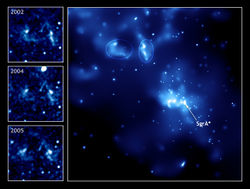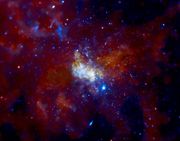Sagittarius A*
 Sgr A* (centre) and two light echoes from a recent explosion (circled) |
|
| Observation data Epoch J2000 Equinox J2000 |
|
|---|---|
| Constellation | Sagittarius |
| Right ascension | 17h 45m 40.045s |
| Declination | -29° 0′ 27.9″ |
| Details | |
| Mass | (4.31 ± 0.38) × 106[1] M☉ or (4.1 ± 0.6) × 106[2] M☉ |
| Astrometry | |
| Distance | 25,900 ± 1,400 ly (7,940 ± 420[3] pc) |
Sagittarius A* (pronounced "A-star", standard abbreviation Sgr A*) is a bright and very compact astronomical radio source at the center of the Milky Way Galaxy, part of a larger astronomical feature at that location (Sagittarius A). Sagittarius A* is likely to be the location of a supermassive black hole,[4] as is hypothesized to be at the centers of many spiral and elliptical galaxies.
Contents |
Description

Astronomers have been unable to observe Sgr A* in the optical spectrum due to the effect of 25 magnitudes of extinction between the source and Earth.[5] Several teams of researchers have attempted to image Sagittarius A* in the radio spectrum using Very Long Baseline Interferometry (VLBI). The current highest-resolution measurement, made at a wavelength of 1.3 mm, indicated an angular diameter for the source of 37 μas.[6] At a 26,000 light-year distance, this yields a diameter of 44 million kilometers. For comparison, the Earth is 150 million kilometers from the Sun, and Mercury is 46 million kilometers from the Sun at its perihelion. The proper motion of Sgr A* is approximately −2.70 mas per year for the right ascension and −5.6 mas per year for the declination.[7]
Supermassive black hole
If the apparent position of Sagittarius A* were exactly centered on the black hole, it would be possible to see it magnified beyond its actual size, due to gravitational lensing. According to general relativity, this would result in a minimum observed size of at least 5.2 times the black hole's Schwarzschild radius, which, for a black hole of around 4 million solar masses, corresponds to a minimum observed size of approximately 52 μas. This is much larger than the observed size of 37 μas and so suggests that the Sagittarius A* radio emissions are not centered on the hole but arise from a bright spot in the region around the black hole, close to the event horizon, possibly in the accretion disc or a relativistic jet of material ejected from the disc.[6]
The mass of Sagittarius A* has been estimated in two different ways. (1) Two groups—in Germany and the U.S.—monitored the orbits of individual stars very near to the black hole and used Kepler's laws to infer the enclosed mass. The German group found a mass of 4.31 ± 0.38 million solar masses[8] while the American group found 4.1 ± 0.6 million solar masses.[2] Given that this mass is confined inside a 44 million km diameter sphere, this yields a density ten times higher than previous estimates. (2) More recently, measurement of the proper motions of a sample of several thousand stars within approximately one parsec from the black hole, combined with a statistical technique, has yielded both an estimate of the black hole's mass, and also of the distributed mass in this region. The black hole mass was found to be consistent with the values measured from individual orbits; the distributed mass was found to be 1.0 ± 0.5 million solar masses[9]. The latter is believed to be composed of stars and stellar remnants.
While, strictly speaking, there are other mass configurations that would explain the measured mass and size, such an arrangement would collapse into a single supermassive black hole on a timescale much shorter than the life of the Milky Way.[6]
The comparatively small mass of this black hole, along with the low luminosity of the radio and infrared emission lines, imply that the Milky Way is not a Seyfert galaxy.[5]
Ultimately, what is seen is not the black hole itself, but observations that are consistent only if there is a black hole present near Sgr A*. In the case of such a black hole, the observed radio and infrared energy emanates from gas and dust heated to millions of degrees while falling into the black hole. Although other possibilities exist for how these gases emanate energy, such as radiation pressure and interaction with other gas streams, interaction with a massive source of gravity is the simplest explanation.[10] The black hole itself is believed to emit only Hawking radiation at a negligible temperature, on the order of 10−14 kelvin.
History
Sgr A* was discovered on February 13 and 15, 1974, by astronomers Bruce Balick and Robert Brown using the baseline interferometer of the National Radio Astronomy Observatory.[11]
On October 16, 2002, an international team led by Rainer Schödel of the Max Planck Institute for Extraterrestrial Physics reported the observation of the motion of the star S2 near Sagittarius A* over a period of ten years. According to the team's analysis, the data ruled out the possibility that Sgr A* contains a cluster of dark stellar objects or a mass of degenerate fermions, strengthening the evidence for a massive black hole.[12] The observations of S2 used near-infra red (NIR) interferometry (in the K-band, e.g. 2.2 μm) because of reduced interstellar extinction in this band. SiO masers were used to align NIR images with radio observations, as they can be observed in both NIR and radio bands. The rapid motion of S2 (and other nearby stars) easily stood out against slower-moving stars along the line-of-sight so these could be subtracted from the images.
The VLBI radio observations of Sagittarius A* could also be aligned centrally with the images so S2 could be seen to orbit the galactic centre. From examining the Keplerian orbit of S2, they determined the mass of Sagittarius A* to be 2.6 ± 0.2 million solar masses, confined in a volume with a radius no more than 17 light-hours (120 AU).[13] Later observations determined the mass of the object to be about 4.1 million solar masses within a volume with radius no larger than 6.25 light-hours (45 AU) or about 6.7 billion kilometres.[2] They also determined the distance to the galactic centre, which is important in calibrating astronomical distance scales, as 8.0 ± 0.6 × 103 parsecs.
In November 2004 a team of astronomers reported the discovery of a potential intermediate-mass black hole, referred to as GCIRS 13E, orbiting three light-years from Sagittarius A*. This black hole of 1,300 solar masses is within a cluster of seven stars. This observation may add support to the idea that supermassive black holes grow by absorbing nearby smaller black holes and stars.
After monitoring stellar orbits around Sagittarius A* for 16 years, Gillessen et al. estimate the object's mass at 4.31 ± 0.38 million solar masses. The result was announced in 2008 and published in The Astrophysical Journal in 2009.[1] Reinhard Genzel, team leader of the research, said the study has delivered "what is now considered to be the best empirical evidence that super-massive black holes do really exist. The stellar orbits in the galactic centre show that the central mass concentration of four million solar masses must be a black hole, beyond any reasonable doubt." [14]
Notes
- ↑ 1.0 1.1 Gillessen et al. 2009
- ↑ 2.0 2.1 2.2 Ghez et al. 2008
- ↑ Eisenhauer et al. 2003, § 3.1
- ↑ Reynolds 2008
- ↑ 5.0 5.1 Osterbrock and Ferland 2006, p. 390
- ↑ 6.0 6.1 6.2 Doeleman et al. 2008
- ↑ Backer and Sramek 1999, § 3
- ↑ Gillessen et al. 2009
- ↑ Schödel et al. 2009
- ↑ Wheeler 2007, p. 224
- ↑ Melia 2007, p. 2
- ↑ Schödel et al. 2002
- ↑ Ghez et al. 2003
- ↑ O'Neill 2008
References
- Backer, D. C. and Sramek, R. A. (20 October 1999). "Proper Motion of the Compact, Nonthermal Radio Source in the Galactic Center, Sagittarius A*". The Astrophysical Journal 524: 805–815. doi:10.1086/307857.
- Doeleman, Sheperd; et al. (4 September 2008). "Event-horizon-scale structure in the supermassive black hole candidate at the Galactic Centre". Nature 455 (7209): 78–80. doi:10.1038/nature07245. PMID 18769434.
- Eckart, A.; Schödel, R.; Straubmeier, C. (2005). The Black Hole at the Center of the Milky Way. London: Imperial College Press.
- Eisenhauer, F.; et al. (23 October 2003). "A Geometric Determination of the Distance to the Galactic Center". The Astrophysical Journal 597: L121–L124. doi:10.1086/380188.
- Ghez, A. M.; et al. (12 March 2003). "The First Measurement of Spectral Lines in a Short-Period Star Bound to the Galaxy’s Central Black Hole: A Paradox of Youth". The Astrophysical Journal 586: L127–L131. doi:10.1086/374804.
- Ghez, A. M.; et al. (December 2008). "Measuring Distance and Properties of the Milky Way's Central Supermassive Black Hole with Stellar Orbits". Astrophysical Journal 689: 1044–1062. doi:10.1086/592738. arXiv:astro-ph/0808.2870. http://adsabs.harvard.edu/abs/2008ApJ...689.1044G.
- Gillessen, Stefan; et al. (23 February 2009). "Monitoring stellar orbits around the Massive Black Hole in the Galactic Center". The Astrophysical Journal 692: 1075–1109. doi:10.1088/0004-637X/692/2/1075. Bibcode: 2009ApJ...692.1075G.
- Melia, Fulvio (2007). The Galactic Supermassive Black Hole. Princeton: Princeton University Press. ISBN 0-691-13129-5.
- O'Neill, Ian (10 December 2008). "Beyond Any Reasonable Doubt: A Supermassive Black Hole Lives in Centre of Our Galaxy". Universe Today. http://www.universetoday.com/2008/12/10/beyond-any-reasonable-doubt-a-supermassive-black-hole-lives-in-centre-of-our-galaxy/.
- Osterbrock, Donald E. and Ferland, Gary J. (2006). Astrophysics of Gaseous Nebulae and Active Galactic Nuclei (2nd ed.). University Science Books. ISBN 1-891389-34-3.
- Reynolds, C. (4 September 2008). "Astrophysics: Bringing black holes into focus". Nature 455 (7209): 39–40. doi:10.1038/455039a. PMID 18769426.
- Schödel, R.; et al. (17 October 2002). "A star in a 15.2-year orbit around the supermassive black hole at the centre of the Milky Way". Nature 419 (6908): 694–696. doi:10.1038/nature01121. PMID 12384690.
- Schödel, R.; Merritt, D.; Eckart, A. (July 2009). "The nuclear star cluster of the Milky Way: Proper motions and mass". Astronomy and Astrophysics 502: 91–111. doi:10.1051/0004-6361/200810922. http://adsabs.harvard.edu/abs/2009A%26A...502...91S.
- Wheeler, J. Craig (2007). Cosmic Catastrophes: Exploding Stars, Black Holes, and Mapping the Universe (2nd ed.). Cambridge, UK: Cambridge University Press. ISBN 0-521-85714-7.
External links
- UCLA Faculty Research presentation on Sagittarius A* (Video)
- UCLA Galactic Center Group - latest results retrieved 8/12/2009
- Is there a Supermassive Black Hole at the Center of the Milky Way? (arxiv preprint)
- 2004 paper deducing mass of central black hole from orbits of 7 stars (arxiv preprint)
- ESO video clip of orbiting star (533 KB MPEG Video)
- Star Orbiting Massive Milky Way Centre Approaches to within 17 Light-Hours ESO Press Release, October 16, 2002
- Max Planck page on the galactic center, with animation
- The Proper Motion of Sgr A* and the Mass of Sgr A* (PDF)
- NRAO article regarding VLBI radio imaging of Sgr A*
|
||||||||||||||||||||||||||||
